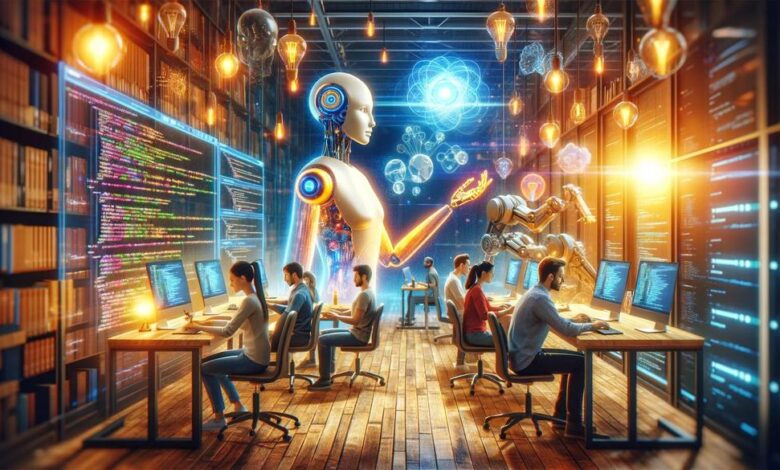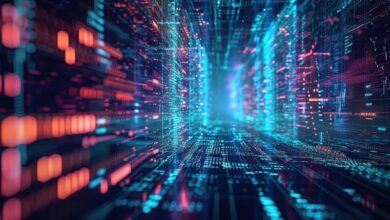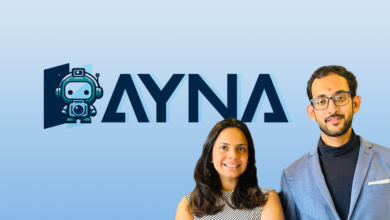Is The Future of AI Coding in Peril? Ethics of Generative AI

In today’s rapidly evolving technological landscape, artificial intelligence (AI) stands at the forefront of innovation. Virtually every industry has felt AI’s transformative touch, and coding is no exception. Recently, headlines have emerged about well-regarded projects like Gentoo Linux and NetBSD taking decisive stances against AI-generated code. These actions spotlight the growing debate on AI’s role in software development.
This article will explore the implications of AI coding, dissect the controversies surrounding its use, and unveil the potential future use cases for AI technologies in collaboration with human intelligence. By breaking down complex concepts into layman’s terms, we’ll ensure that you, the reader, understand not just the technology but the far-reaching consequences and opportunities it presents.
Understanding AI and Generative AI
What is Artificial Intelligence?
Artificial Intelligence, or AI, is a field within computer science focused on creating machines that can perform tasks requiring human intelligence. These tasks encompass problem-solving, understanding natural language, recognizing patterns, and making decisions.
AI can be found in everyday products like smartphones, which help with features such as voice recognition (think Siri or Google Assistant), navigation, and even photo enhancements. In essence, AI is about creating smarter gadgets and applications that can perform specific tasks more efficiently than ever before.
Generative AI: A New Frontier
Generative AI represents a specific field within AI that involves creating new content. This could include generating images, writing poetry, composing music, and, notably, writing code. Generative AI systems learn from vast amounts of data to produce meaningful content that seems like it was created by humans. For example, tools like ChatGPT can generate conversational text, while DALL-E creates images from textual descriptions.
Generative AI has caught the world’s attention because of its ability to automate and assist in a variety of tasks across multiple domains. However, as we’ll discuss, it’s not without its challenges and limitations.
How Does Generative AI Work?
To grasp how Generative AI functions, it’s crucial to understand a few key concepts in simpler terms.
Large Language Models (LLMs)
Generative AI relies heavily on Large Language Models (LLMs). These are advanced algorithms that have learned to predict and generate text based on patterns they’ve observed in the data they’ve been trained on. Imagine teaching a computer to complete your sentences based on the words you’ve typed so far. LLMs do this on a much grander scale.
An LLM, like OpenAI’s GPT-4, is trained using vast collections of text data, which could include anything from books and articles to social media posts and programming codes. Through this training, the model learns the structure of the language, common phrases, and the context in which words are used. This enables the model to generate coherent and contextually appropriate responses or content.
The Role of Training Data
Training data is essentially the information fed into AI models to help them learn. For Generative AI to be effective, it needs a large amount of diverse and high-quality data. The more varied the training data, the better the AI can understand different contexts and nuances in language. For example, if an AI is trained on a variety of programming languages, it can generate code snippets in multiple languages.
However, using extensive datasets also introduces risks. If the data includes copyrighted material or biased content, the model might inadvertently reproduce these issues in its outputs, leading to ethical and legal complications.
Algorithms and Transformers
At the heart of Generative AI lie complex algorithms known as transformers. These algorithms analyze the training data and build statistical models that predict how words should follow each other. A transformer works similarly to the auto-complete feature on your smartphone but on a much larger and more sophisticated scale.
Transformers break down the text into smaller pieces and then determine the probability of certain word sequences appearing together. This process allows the AI to generate text that is not only grammatically correct but also contextually relevant. For instance, if you ask an AI to write a paragraph about climate change, it uses its understanding of language to provide an informative and coherent response based on the patterns it has learned.
Understanding Generative AI: Potentials and Challenges
Generative AI employs LLMs, vast amounts of training data, and sophisticated algorithms to create new and useful content. It mimics human-like creation by recognizing and reproducing patterns in data, making it a powerful tool with significant potential, albeit accompanied by notable challenges and controversies.
By demystifying these fundamental concepts, we can better appreciate the complexities and capabilities of Generative AI. The subsequent sections will dive deeper into the implications and address how we can harness this technology responsibly while navigating its inherent challenges.
Implications of AI Coding
Controversies and Challenges of AI-Generated Code
As with any groundbreaking technology, AI-generated code brings its own set of controversies and challenges. Understanding these issues is crucial to navigate the potential pitfalls while harnessing the benefits.
Ethical and Legal Concerns
One of the most significant concerns relates to copyright and intellectual property. Generative AI models are trained on vast datasets that include a wide range of texts, such as books, articles, and even code from various repositories. Despite the AI generating new content, there’s a risk that it might replicate copyrighted material inadvertently. For example, if an AI has been trained on proprietary code, it might reproduce parts of this code without proper authorization, leading to legal complications.
Ethical concerns also arise from how these AI models are trained. The process involves vast amounts of data, which often includes user-generated content from social media and forums. This raises questions about data privacy and the ethical use of personal data. Moreover, the environmental impact of training these large models is significant, considering the computational power required.
Quality and Reliability Issues
Another major challenge is the issue of quality. AI-generated code can sometimes suffer from what’s called “hallucination,” where the AI creates plausible-looking but incorrect or nonsensical code. This phenomenon occurs because the AI is essentially making educated guesses based on patterns it has seen in its training data, which can sometimes lead to errors.
Studies have shown that the use of AI can lead to increased “code churn,” which is the tendency for code to be rewritten or discarded shortly after being created. This can cause instability in software development projects, as frequent changes introduce more opportunities for errors to slip through unnoticed. According to research analyzed by GeekWire, code churn rates have significantly increased with the adoption of AI coding tools.
Impact on Software Development Practices
The widespread use of AI in coding has also introduced the concept of “AI-induced technical debt.” This term refers to the accumulation of problems that arise when quick, short-term solutions are favored over more sustainable, long-term strategies. AI tools can generate large quantities of code quickly, but maintaining and debugging this code can be challenging, especially if it’s not well-integrated with the rest of the project.
Furthermore, there are concerns that reliance on AI tools might lead to a devaluation of human skills. If developers come to depend too heavily on AI assistance, they may not develop the problem-solving and critical-thinking skills necessary to handle complex coding challenges independently.
Future of AI Coding: Human-Machine Collaboration
As we delve into the changing world of AI in coding, it’s crucial to think about how developers, organizations, and the broader tech industry can adopt AI responsibly and effectively. This approach helps us leverage AI’s advantages and tackles its challenges head-on.
Balancing AI and Human Coding Efforts
The future of coding isn’t a choice between AI and human coders; it’s about finding the right balance where both can complement each other. AI tools excel at automating repetitive tasks, generating code snippets quickly, and suggesting improvements. However, human expertise is crucial for strategic decision-making, creative problem-solving, and ensuring that the final code is robust and sustainable.
For example, an AI tool might create the basic structure of a web application. Human developers can then concentrate on improving the user experience and ensuring strong security measures. They can also tailor the application to meet specific user requirements. This collaborative method boosts productivity and results in superior final products.
Continuous Learning and Adaptation
In the rapidly evolving tech landscape, ongoing education is crucial. Developers need to keep up with the latest innovations in both programming and artificial intelligence. Resources such as workshops, online courses, coding boot camps, and professional development programs are essential for gaining new skills and staying current with industry trends.
Moreover, understanding the fundamentals of AI and machine learning can help developers leverage these tools more effectively. By gaining insights into how AI models are trained, how they function, and their limitations, developers can make better-informed decisions about when and how to use AI in their projects.
Incorporating AI Tools into Workflow
To fully harness the power of AI, developers should actively incorporate AI tools into their workflows. This involves experimenting with different AI-driven coding assistants, debugging tools, and optimization algorithms to find the ones that best fit their needs.
For example, using AI tools like GitHub Copilot or Amazon CodeWhisperer can streamline coding tasks, automate routine activities, and provide intelligent code suggestions. By incorporating these tools into their everyday routines, developers can boost their productivity. This allows them to devote more time to the complex and creative elements of their projects.
Future-Proofing Careers
As AI continues to evolve, developers must future-proof their careers by adapting to emerging technologies. This means being open to incorporating AI tools into their work and understanding how these tools can complement their existing skills.
Developers should also focus on honing their soft skills, such as problem-solving, critical thinking, and effective communication. These skills are invaluable in an AI-augmented world, where collaboration between humans and machines is key to success.
By embracing a mindset of continuous learning and adaptability, developers can position themselves as valuable assets in the tech industry, ready to navigate the evolving demands of the field.
Potential Use Cases for AI Coding
Despite the challenges, the potential use cases for AI coding are vast and promising. Here’s a look at some of the most exciting applications of AI in software development.
Accelerated Development and Prototyping
One of the most straightforward applications of AI in coding is accelerating development and prototyping. AI tools can automate the creation of boilerplate code—the repetitive and often tedious code that forms the basic structure of software applications. By handling routine tasks, AI enables developers to concentrate on more intricate aspects of a project.
For example, AI can swiftly create the basic framework for a web application, establishing the initial file structure and generating standard functions. This streamlines the development process, ensures consistency, and minimizes the chances of human error.
Advanced Debugging and Error Detection
AI’s ability to analyze vast amounts of data can be harnessed to improve debugging and error detection. Advanced AI-powered debugging tools can scan through code to identify potential errors or vulnerabilities much faster than a human could. These tools can provide suggestions on how to fix these issues, streamlining the debugging process.
For example, AI-driven tools can detect patterns in code that are likely to cause bugs, such as improper variable initialization or memory leaks. By identifying these issues early in the development cycle, AI helps prevent costly and time-consuming fixes later on.
Learning and Development Enhancements
AI has significant potential to enhance learning and development for both novice and experienced programmers. AI-driven educational tools can provide personalized guidance and tutorials, helping users understand complex coding concepts through hands-on examples and tailored advice.
For example, a beginner programmer might turn to an AI tutor to learn a new programming language. The AI can offer step-by-step guidance, simulate coding environments, and create interactive exercises tailored to the learner’s progress and performance. This personalized method enhances both engagement and effectiveness in learning.
Innovative Application Development
AI can also play a crucial role in developing innovative applications that were previously difficult or time-consuming to create. For example, natural language processing (NLP) applications, which require sophisticated algorithms to understand and generate human language, can greatly benefit from AI.
Developers can leverage AI to build sophisticated chatbots, voice recognition systems, and translation services. These applications can engage users more naturally and intuitively, improving the user experience and broadening the software’s functionality.
Navigating the Ethical Landscape
Considering the profound impact and challenges of AI in coding, it is crucial to approach the ethical landscape with care. Below are some considerations and recommendations to keep in mind.
Human Oversight and Review
To mitigate risks associated with AI-generated code, it’s crucial to incorporate human oversight at every stage of the development process. Human reviewers should carefully examine AI-generated code to ensure it meets quality standards and does not violate any legal or ethical guidelines.
For example, before integrating AI-generated code into a project, developers should review it for accuracy, completeness, and compliance with coding standards. This human oversight helps catch potential issues that AI might overlook, ensuring that the final product is reliable and secure.
Transparency and Data Management
Transparency in how AI models are trained and used is essential to building trust and ensuring ethical use. Developers and organizations should be transparent about the data sources used to train AI models, as well as the potential biases and limitations of these models.
Clear documentation of data sources can help mitigate concerns regarding copyright and data privacy. Additionally, organizations should implement robust data management practices, ensuring that the data used is accurate, representative, and ethically sourced.
Sustainability Practices
Considering the environmental impact of training and deploying AI models, developers, and organizations should strive for sustainability. This can include optimizing models to reduce computational demands and using renewable energy sources for data centers.
By adopting energy-efficient practices, the tech industry can minimize the environmental footprint of AI technologies. This not only benefits the environment but also sets a positive example for responsible innovation.
Ethical Use and Accountability
For organizations, it is essential to establish clear guidelines and policies for the ethical use of AI. These guidelines should outline the roles and responsibilities of stakeholders, from developers to end-users, in ensuring responsible AI usage.
Additionally, organizations need to create accountability mechanisms to address any ethical issues. This can include forming ethics committees, conducting regular audits, and offering training and resources to help employees navigate ethical challenges. By promoting a culture of ethics and accountability, organizations can ensure that AI technologies are developed and used beneficially while minimizing potential risks.
AI in coding offers exciting possibilities, but it also brings challenges and ethical concerns. By understanding these issues and adopting responsible practices, we can leverage AI to enhance software development. This paves the way for a future where human and machine intelligence collaborate effectively.
AI Coding Revolution: Opportunities and Responsibilities
As we stand on the cusp of an AI-driven revolution in coding, it’s clear that the integration of AI into software development presents both exciting opportunities and significant challenges. By understanding the implications of AI-generated code, addressing ethical and quality concerns, and exploring potential use cases, we can unlock the full potential of AI while ensuring responsible and sustainable innovation.
The future of coding is not a battle between humans and machines. Instead, it is a collaborative journey where AI augments human capabilities, automates routine tasks, and provides intelligent insights while human developers bring creativity, critical thinking, and strategic decision-making to the table.
To thrive in the future, developers and organizations need to see AI as a crucial collaborator. They must commit to ongoing education and stay adaptable to changing technologies. This approach will enable a future where human and artificial intelligence collaborate effectively. Together, they can drive innovation and produce high-quality, impactful software solutions.
While the road ahead may be filled with uncertainties, the possibilities are limitless. By fostering a culture of ethics, transparency, and accountability, we can ensure that AI technologies are developed and used in ways that benefit society as a whole. As we move forward, let us embrace the potential of AI in coding, not as a replacement but as a collaborative force that empowers us to achieve unprecedented heights in software development.



